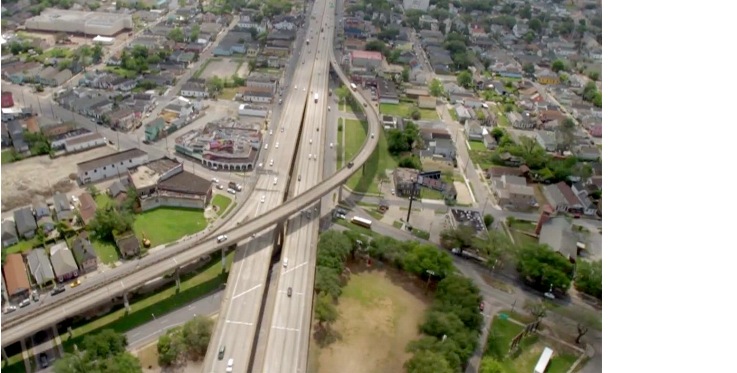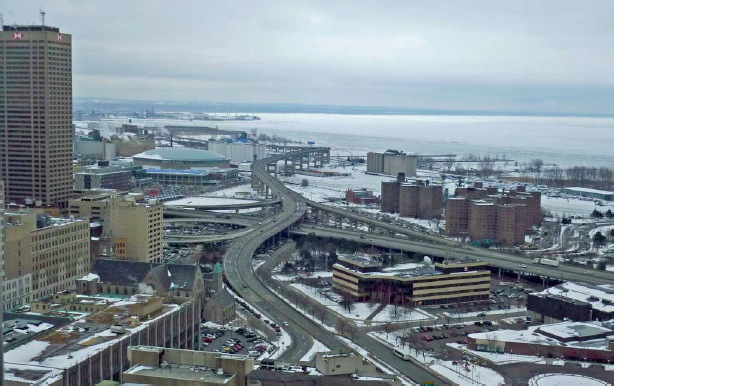CONGRESS FOR THE NEW URBANISM
The Congress for the New Urbanism believes that, in an urbanized context, streets should add value to the places they serve. The street network is not just for moving vehicles, it is also the setting for commerce and social interaction; its primary function is to serve people and society. Freeways are incompatible with street networks in the urban context because they only serve motor vehicles, limit transportation options, are inherently disconnected from their adjacent surroundings and thus disrupt an otherwise functional street network.
CNU advocates for replacing urban freeways with surface streets, boulevards and avenues as the most cost-effective, sustainable option for cities grappling with aging grade separated roads. This has the added benefit of providing significant opportunities to heal local street networks and improve regional traffic dispersion. As federal and state DOTs confront shrinking budgets, and cities look for ways to increase their tax base and revenues, community and political support is building for connected street grids and improved transit options that are less expensive to maintain and offer better alternatives to the rebuilding of urban freeways.
Successful freeway removal campaigns are characterized by strong community and political leadership; a decision-making process driven by long-term mobility planning, not cyclical federal and state allocations; and a vision for the urbanized environment that is not dictated solely by the fast movement of motor vehicles. CNU’s Highways to Boulevards initiative unites a diverse set of professionals, residents and activists in advocating for these outcomes and demonstrating the value of urban freeway removal by restoring urban neighborhoods and historic street networks.
CNU serves as a hub for the freeway removal movement, and provides support for advocates and officials in several ways. In 2013, with generous support from the Ford Foundation, CNU convened a national advisory board of experts and activists to discuss best practices and strategies for freeway teardown campaigns. CNU also distributed a survey to assess public support for urban freeway teardown projects, and regularly collects and compiles data on current and potential teardowns into a North American urban freeway database.
The 2014 Freeways Without Futures Report lists the top opportunities in North America for replacing aging urban highways with boulevards or avenues that connect to the networks of streets. They are presented in no particular order of rank. As in previous reports, the criteria for the 2014 list is based on a number of factors: the age and design of structures, redevelopment potential, potential cost savings, ability to improve both overall mobility and local access, existence of pending infrastructure decisions, and community support.
If you know a freeway that warrants consideration as an urban revitalization opportunity – please contact Alex McKeag, CNU Program Manager, at amckeag@cnu.org.
I-10/Claiborne Overpass, New Orleans
In the 1960s, elevated Interstate 10 (I-10) was built directly over Claiborne Avenue, a thriving commercial strip in the neighborhoods of Tulane/Gravier, Tremé/Lafitte and the 7th Ward. In 1966, the oak trees that lined the avenue were destroyed or, in some cases, transplanted to other parts of the city and were replaced by concrete columns to support the highway. Some 500 homes, businesses and other buildings were removed to make room for the new highway. As a result of the highway construction, Tremé —one of the first free African- American communities, and once one of the wealthiest — was left physically divided and socially marred.
Following the devastation of Hurricane Katrina in 2005 and the subsequent rebuilding efforts, there was an increasing call to rethink I-10’s role in the North Claiborne Corridor, especially in light of the age of the structure and the damaged sustained by the storm. The Unified New Orleans Plan (UNOP), a comprehensive planning process to coordinate recovery and rebuilding after Hurricane Katrina, suggested that the removal of I-10 “would have considerable positive impacts by re-connecting neighborhoods and restoring what was once a beautiful tree-lined avenue. Traffic redistribution provides economic development benefits to a corridor ripe for more volume.” The UNOP predicted that with the full removal of two miles of the elevated I-10, the city could reclaim 35 to 40 city blocks that would no longer be devalued by the freeway as well as 20 to 25 blocks of open space.
In 2012, an encouraging federal policy shift occurred. The Department of Housing and Urban Development (HUD) and the U.S. Department of Transportation (USDOT) jointly awarded a $2 million grant – with matching funds put forth by the City of New Orleans and local non-profits — to engage stakeholders in the study area to develop three alternatives for the Claiborne Corridor. After more than a year of public engagement, The Livable Claiborne Communities study concluded its final meeting in October 2013. The study outlines four scenarios for the future of the Claiborne corridor, including removing the elevated expressway from Tulane Ave to St. Bernard, redistributing traffic on local streets, taming and removing of expansive interchanges, and creating more livable conditions for neighborhood residents.i [Image: Still from Claiborne Avenue: Past, Present and Future]
Route 5/Skyway, Buffalo
Completed in 1956, this 1.4-mile long, 110-foot tall limited-access Skyway Bridge begins at the Inner Harbor downtown, crosses the Buffalo River and touches down as Route 5 in the Outer Harbor. Route 5 continues for another 2.6 miles as a limited-access expressway built on an embankment of slag. It mars public views of the adjacent waterfront, depreciates land values and hinders both public and private redevelopment efforts. The highway’s oddly configured exit ramps lead to a confusing series of one-way streets that further hinder access to the waterfront, There is no pedestrian access between downtown and the Outer Harbor. A total of 41,500 vehicles per day travel along this blighted corridor.
A coalition of citizens and civic organizations, including members of the Buffalo Common Council, New York State Assemblyman Michael Kearns, and CNU continue to call for the Skyway to come down and the replacement of urban sections of Route 5 through Buffalo with a surface boulevard. Removal advocates tout the boulevard and connecting urban street grids’ environmental and economic development benefits for downtown and waterfront redevelopment. The DOT rates the Skyway bridge as “fracture critical” while the Federal Highway Administration classifies the bridge as “functionally obsolete.” It is likely to cost more than $50 million to maintain over the next two decades.
In 2013, Commissioner of the New York State Department of Transportation Joan McDonald directed her office to conduct a plausibility review of the route. NY Senator Tim Kennedy, joining a chorus of fellow lawmakers demanding the Skyway come down, has insisted that the DOT make these findings public, evoking removal as a way to further catalyze waterfront development in downtown Buffalo. As of January 2014, the results of the review have not been released. [Image: Payton Chung via flickr]
Download full version (PDF): 2014 Freeways Without Futures
About the Congress for the New Urbanism
www.cnu.org
“The Congress for the New Urbanism (CNU) is the leading organization promoting walkable, mixed-use neighborhood development, sustainable communities and healthier living conditions. For over twenty years, CNU members have used the principles in CNU’s Charter to promote the hallmarks of New Urbanism, including:
- Livable streets arranged in compact, walkable blocks.
- A range of housing choices to serve people of diverse ages and income levels.
- Schools, stores and other nearby destinations reachable by walking, bicycling or transit service.
- An affirming, human-scaled public realm where appropriately designed buildings define and enliven streets and other public spaces.”
Tags: Buffalo, CNU, Congress for the New Urbanism, LA, Louisiana, New Orleans, New York, NY








 RSS Feed
RSS Feed